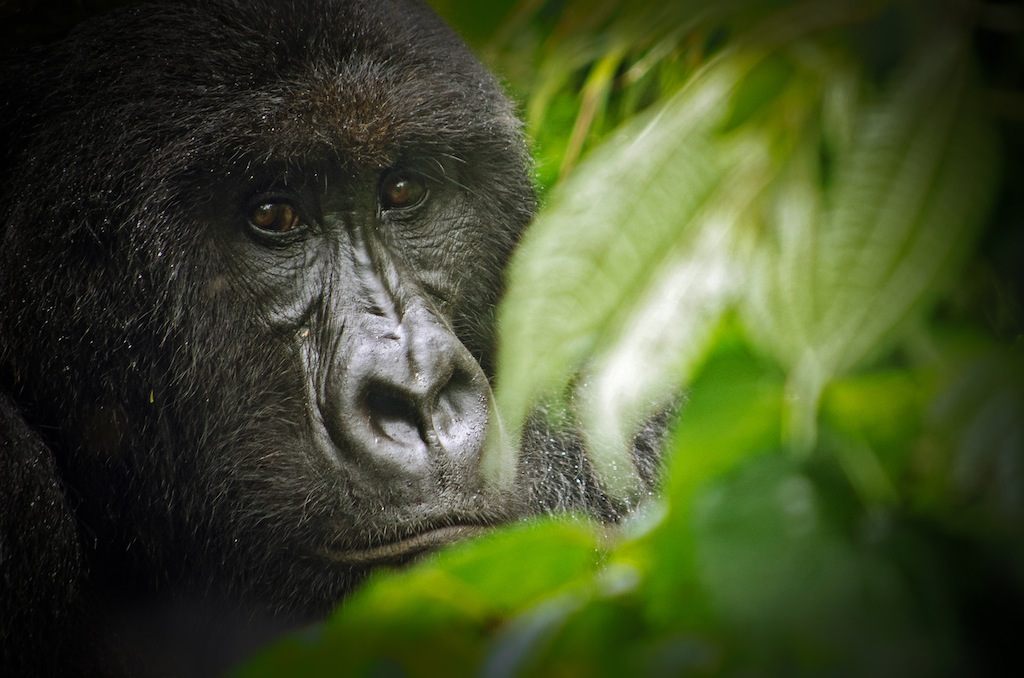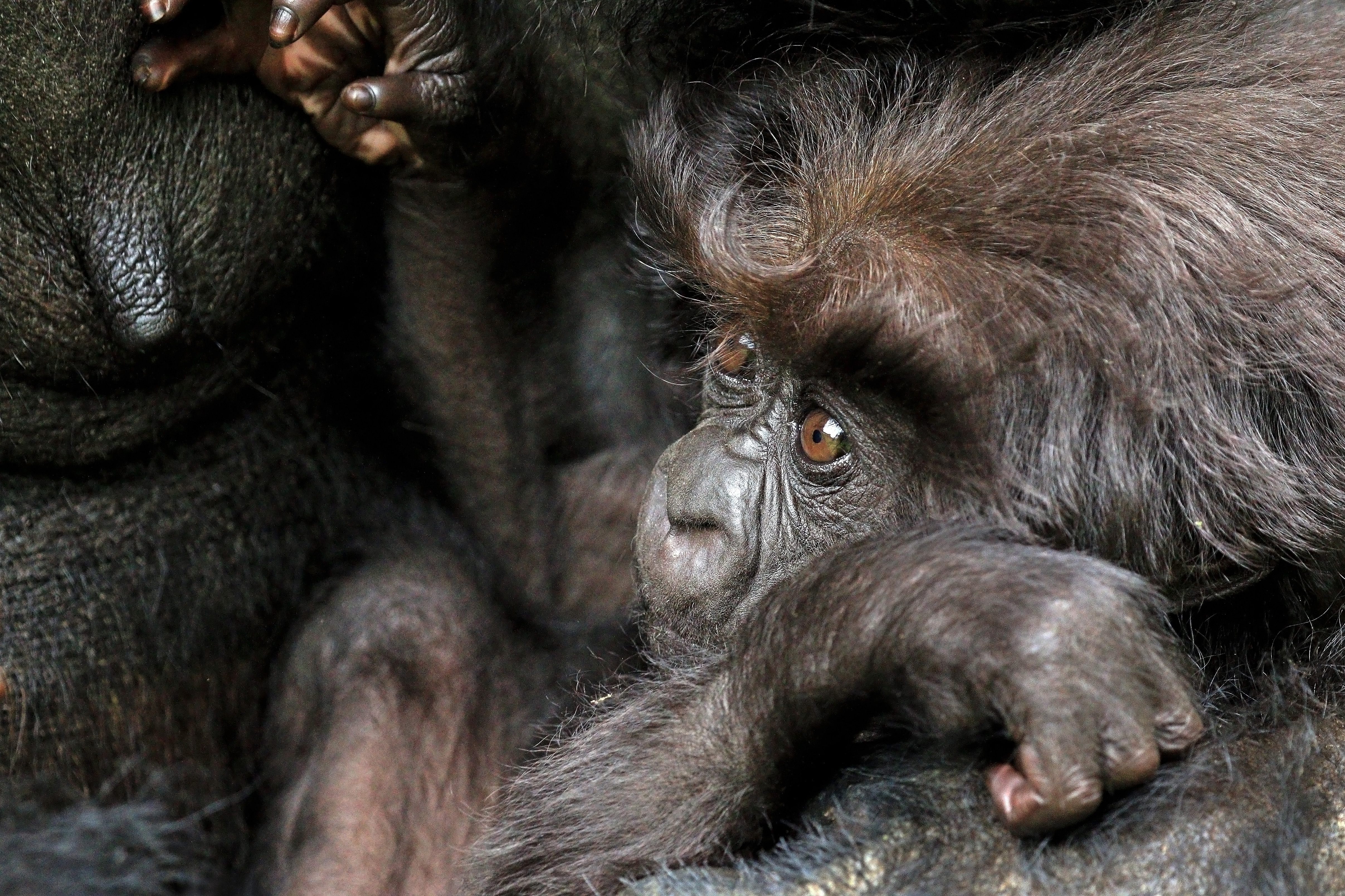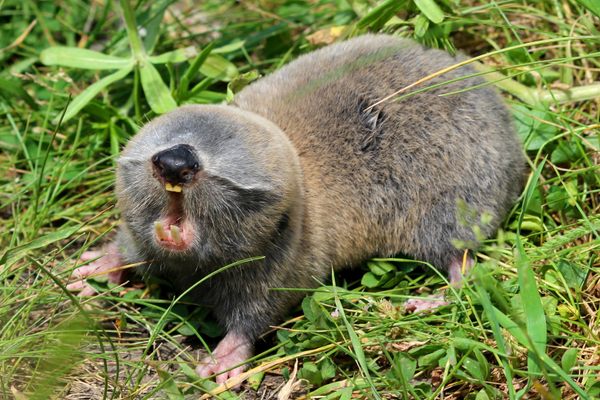A Gorilla Poop Treasure Hunt Through Central Africa’s Virunga Volcanoes
How researchers collect genetic info without disturbing the majestic primates.

In 2015 and 2016, troops of field researchers spent weeks slogging through the thickly forested Virunga Mountains, a volcanic ridge that slices across Rwanda, Uganda, and the Democratic Republic of the Congo. It was cold and humid, steep and slow-going. Sometimes, they’d only press on for a mile or so each day, machetes in hand, and return to camp exhausted. Their goal? Treasure troves of gorilla poop.
For decades, one method of tracking and counting rare mountain gorillas has involved following their tracks and looking for glimpses of hair. Scientists kept their eyes peeled for fractured bamboo or squashed vegetation, but this has never been an easy way to conduct a census. Paths splinter, jump, and veer off in unexpected directions, or dead-end if an animal decided to scale a tree.
Eyeball counts like that are still used for habituated populations—gorillas that are accustomed to the presence of humans. Researchers have given these creatures names and visit them every day. They know when they’re sick, when one is born, when one dies. But there are other gorillas that researchers know much less about, ones that live deeper in the forest. The prevailing wisdom, these days, is that they should get a wide berth. “We don’t want to meet them, and we don’t want to disturb them,” says Anne-Céline Granjon, a graduate student in primatology at the Max Planck Institute for Evolutionary Anthropology in Leipzig, Germany.

Mountain gorillas, one of the two or three subspecies of eastern gorilla, are highly endangered, and war and unrest have changed their world. By the mid-1980s, their numbers dwindled to around 250 individuals. Their ranks appear to have been buoyed by conservation efforts, but data about exactly how many there are, and where, are hard to come by.
When the International Gorilla Conservation Programme—a project of the World Wide Fund For Nature and Flora & Fauna International, which collaborates with parks and local experts across all three nations—set out to conduct that recent census, they wanted data but no close contact. So their field teams followed tracks, too, but in the opposite direction: back to the gorilla’s nests. Like chimps, gorillas bend branches and leaves into little beds. When they wake up in the morning, they relieve themselves, and so their poop became a proxy.
“We basically look for the poop, and we do genetic analysis and look for DNA fingerprints, the way you would at a crime scene,” says Granjon, who trained local field teams and performed the genetic work. The idea was that by studying the stool samples, researchers could get a better grasp of how many individuals there are, and where those individuals had been spending their time.
If gorillas are rare, their scat isn’t, so the researchers had far more material than they could ever need. “They leave too much poop, these gorillas, they poop all the time,” says Granjon. Gorillas heed this call every few hours, and each time produces as much as a large human bowel movement—male mountain gorillas routinely top 350 pounds. But their leavings aren’t particularly rank. “They’ve herbivores, so it doesn’t smell so much,” Granjon says. “It smells when you’re above it, but not from a distance.”

In their search, the field teams walked more than 1,200 miles to cover 170 square miles of habitat. At the nests, they placed walnut-sized stool samples into vials, and labeled them with GPS coordinates for analysis back at the Max Planck Institute laboratories. A given nest was only sampled once, unless it contained piles that looked really different, which could suggest a baby with its mother. Since DNA degrades in heat and humidity, each tube contained a high-percentage ethanol, which helped push water out of the sample. The following day, they were transferred to another tube, containing silica beads to continue the dehydration process.
No matter how swiftly and thoroughly dried the sample is, though, fecal forensics isn’t ideal. “Poop DNA is not the most perfect DNA one can find in the world,” Granjon says. Samples from blood and other tissues yield more precise results. Because fecal matter hangs around in the forest for a few days, exposed to sun, rain, and other animals, Granjon says, “it’s already pretty fragmented to begin with.” The samples have to be run several times, and since the mountain gorilla population has been low for years, Granjon says, they’re fairly inbred and the genetic differences are subtle. The scientists can tell individuals apart, but can’t necessarily construct detailed family trees.

Even so, the 1,100 samples generated a lot of data, and Granjon was able to revise the estimate of the number of gorillas in the area. By her count, announced last week, there are at least 186 unhabituated gorillas, in addition to the 418 habituated ones that researchers or tourists routinely see. Overall, this suggests a 26 percent increase from the last census in 2010. “This represents one of the rare success stories in conservation,” said Martha Robbins, a research scientist and gorilla expert at the Max Planck Institute, in a statement. “The population of mountain gorillas in the Virunga Volcanoes has more than doubled in the past three decades, despite intensive threats of poaching, habitat degradation, and civil conflict.”
It’s possible that a degree of geopolitical stability helped arrest the gorillas’ decline since the end of the Second Congo War in 2003, but fatal skirmishes between rangers, militia, and smugglers are still common in the region. In response, Virunga National Park, home to many of the surviving mountain gorillas, will be closed to tourists until 2019, chief warden Emmanuel de Merode announced this week. “It is abundantly clear that the Virunga is deeply affected by insecurity and that this will be the case for some time,” he said in a statement. All primates there—humans and gorillas alike—are vulnerable.
It also remains to be seen how much of the increased gorilla count is due to better methodology, and how much represents a real increase in the population. Chances are it’s a bit of both, and researchers have reason to believe that there are more out there that their count missed. In the future, the team plans to use statistical analysis to take a guess at how many more there might be. “Probably,” Granjon says, “there are a lot of gorillas we still haven’t found.”























Follow us on Twitter to get the latest on the world's hidden wonders.
Like us on Facebook to get the latest on the world's hidden wonders.
Follow us on Twitter Like us on Facebook